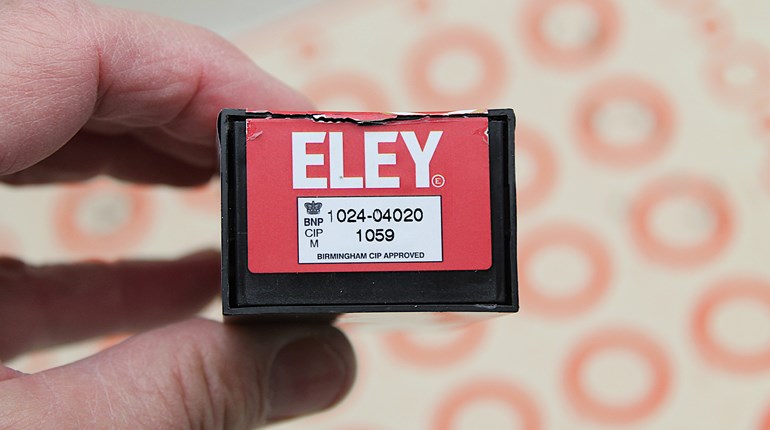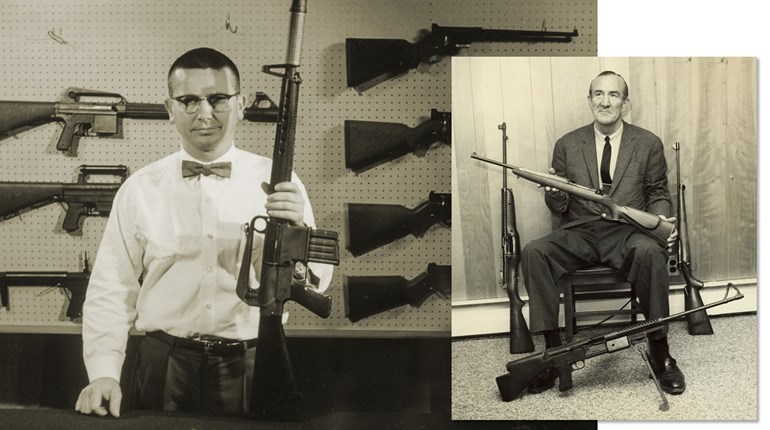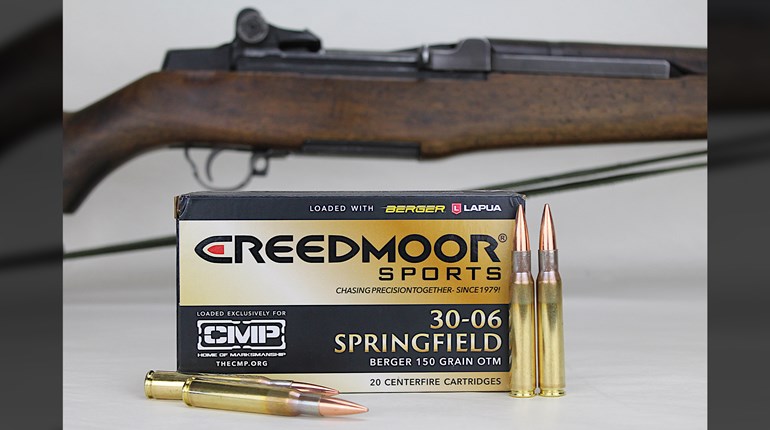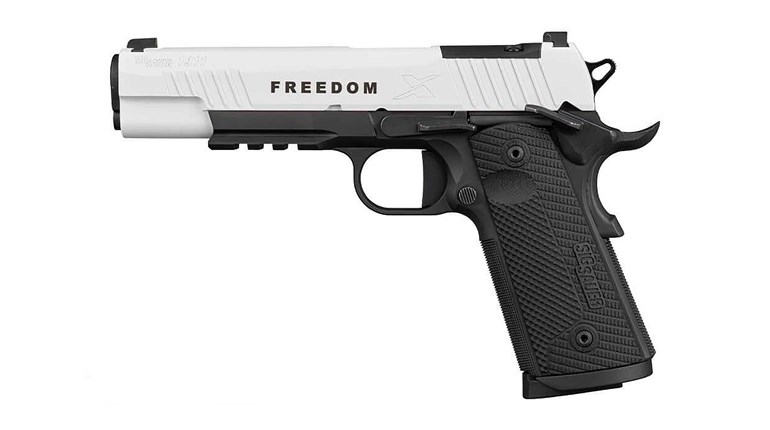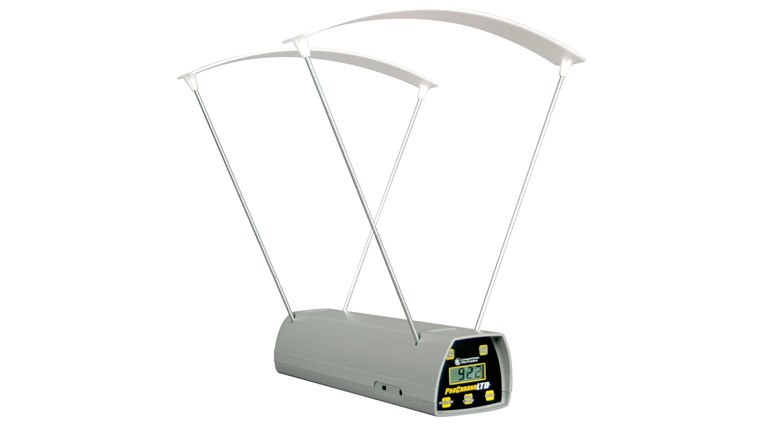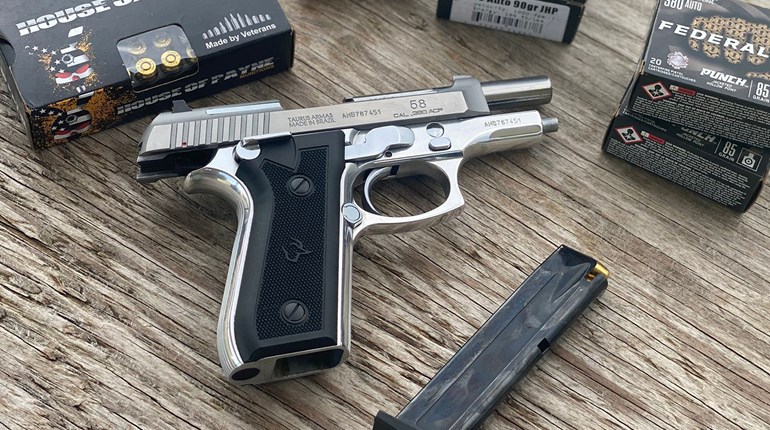
Owing to its modular design, the adaptability of the modern sporting rifle (MSR) is unparalleled; in fact, it’s the only platform with which the highly subjective term “perfection” can be quickly, easily and affordably achieved for a large (and growing) segment of the shooting public. Given the quantity of both small- and large-scale AR parts and accessories manufacturers—particularly in the aftermarket—there’s something to satisfy even the most-discriminating palate. Such holds true of chamberings, too. Within the AR-15 platform, however, where cartridge options range from
.22 LR to .50 Beowulf, the ubiquitous 5.56 NATO still reigns supreme. But, quickly growing in popularity are the stalwart 7.62x39 mm and the newer .300 AAC Blackout that, ballistics-wise, can be quite similar. That’s where the primary parallels end; there are real, noteworthy differences to consider when contemplating the cartridge to best fit your shooting needs.
 The Stalwart: 7.62x39 mm
The Stalwart: 7.62x39 mm
It could be said that Nazi Germany’s 7.92x33 mm Kurz, a shortened version of the 8 mm Mauser (aka 7.92x57 mm), left an indelible impression on the Soviet army. In fact, shortly after facing the cartridge in battle in Cholm, Russia, in 1942, the USSR commenced creating its own intermediate-range infantry cartridge. The resulting round, the 7.62x39 mm (7.62x39 mm Soviet M43), was (and still is) one of the best cartridges for its intended purpose—medium-range engagements using maneuverable selective-fire individual arms.
With a body tapering from .443 to .396 inches along its length and a relatively shallow 17 degree, 30-minute shoulder angle (the same as the .30-’06 Sprg.), the rimless, bottleneck M43 reliably feeds, fires and extracts in a range of arms and environs, including debris-filled deserts and the frozen tundra. During World War II, such arms included the semi-auto SKS-45 and full-automatic RPD. The rifle with which the chambering is inexorably linked, the select-fire AK-47, was not ready for military trials until after the war ended. SKS and AK-47 rifles are still the arms most commonly chambered for this efficient, ultra-reliable cartridge.
The cartridge’s 1.528 inch-long case holds sufficient propellant to attain a nominal muzzle velocity of 2,350 fps with a 123-grain FMJ bullet, placing it between the 7.62x25 mm Tokarev and 7.62x54 mm R, two other Russian creations, with regard to external and terminal ballistics (energy, range, etc.), recoil and physical size. As such, it’s ideal for engagements out to about 400 yards. Because of the circumstances surrounding, and locations of, world conflicts since its unveiling, this “middle-ground” cartridge has proven time and again to be particularly well-suited for the “modern” battlefield—spitting distance engagements in jungles and city streets, where the extra energy and reach offered by full-length rifle rounds, such as the 7.62x54 mm R, is generally unnecessary.
The proliferation of the SKS and, especially, the AK-47, was (and is) a “double-edged sword” for the 7.62x39 mm cartridge; whereas the utterly reliable rifles created widespread use of the round and established its reputation as a fight-stopper, the arms’ lackluster accuracy, which was not helped by the manner in which they were (and are) employed, have unfairly painted it as an inaccurate round. Such is not the case. In fact, two of the most-accurate cartridges extant, the .22 PPC and 6 mm PPC, were derived from the .220 Russian case, which itself is based upon a necked-down 7.62x39 mm. That speaks volumes.
An absence of anything but low-quality, surplus-type ammunition didn’t improve perception of the cartridge, either. Said ammunition generally offers dependable firing, but less-than-stellar accuracy. Yet, such ammo offered unequalled value, which led to acceptance of surplus arms in the chambering, especially the SKS. Thanks to pre- and post-election hoarding, much of the Cold War-era supplies of surplus 7.62x39 ammunition have dried up, but the ability of foreign makers (especially in Russia) to produce high volumes of steel-case ammunition at low cost remains. Thus, the primary allure of the Soviet creation is acceptable-quality ammunition at minimal cost.

There is no large-caliber, centerfire cartridge that approaches the 7.62x39 mm for value. Don’t expect sub-MOA accuracy from this discount ammunition, but it’s perfectly acceptable for plinking and practice. The primary consumers of 7.62x39 mm ammunition have inexpensive arms (i.e. SKS and AK-47) that are fed equally low-cost ammunition. Unless used for personal protection or hunting, seldom will the owners of the aforementioned rifles pair them with top-notch loads. As such, relatively little research and development has been employed in creating “premium” offerings; quite simply, the demand is thought to be too small to warrant it. That being said, Hornady, Federal (Fusion), Cor-Bon, DoubleTap, Remington and Winchester each have one or more options suitable for self-defense or hunting.
MSR manufacturers follow one of two paths when designing an AR around the 7.62x39 mm. Companies such as Rock River Arms (LAR-47 X1) and CMMG (Mutant) developed rifles to utilize the widely available AK-47 magazines, but the use of unique, medium/large-frame receivers and specialized components nullify many other aftermarket options. Moreover, low-capacity, five- and 10-round AK magazines, which are needed for hunting or ownership in certain locales, are few in number. Arsenal Inc. offers them, but whether or not they’ll work in your 7.62x39 mm-chambered AR is another story. Some guns can be fickle about magazines. Keep in mind that 30-round AK magazines can make prone shooting difficult.

Other manufacturers, such as Windham Weaponry, Patriot Ordnance, ArmaLite, Bushmaster, Olympic Arms and LWRC use AR-15-size receivers and AR-style magazines. The trade-off is a lighter, more-compact platform with less-reliable feeding. Even 7.62x39 mm-specific AR-style magazines have a reputation for poor feeding, as evidenced on forums and product re-views. That has changed in recent years as the popularity of the chambering in AR platforms has grown. Of course, other changes, such as the bolt, firing pin and extractor must be made to accommodate the larger cartridge, so the interchangeability of these parts isn’t possible.
Which rifle (or upper) selected will most likely depend on your circumstances. Do you currently have an AR, or will this be your first? More-over, do you have an AK-47 or a bunch of AK magazines? Each has pros and cons. The Newcomer: .300 AAC Blackout
The Newcomer: .300 AAC Blackout
One cannot introduce the SAAMI-approved .300 AAC Blackout without first describing its virtually identical CIP-approved predecessor, the .300 Whisper. Designed by prolific wildcatter J.D. Jones in the early 1990s, the .300 Whisper—a necked-up .221 Rem. Fireball loaded with light- and heavy-for-caliber bullets to supersonic and subsonic velocities, respectively—was created for enhanced external and terminal performance (over 5.56 NATO) in the M16 platform while using existing magazines loaded to full capacity. For clandestine work, subsonic loads were paired with sound suppressors, which Jones’ SSK Industries also built. Only SSK Industries and T/C Arms could legally use the trademarked “Whisper” name; some skirted the issue by using creative names, such as .300 Fireball and .300-221; same premise, different name. The problem was, there were dimensional variations stemming from companies bypassing Jones’ original work.
Now, fast-forward to 2009, when Advanced Armament Corp. (AAC) presented the .300 Blackout schematics to SAAMI for approval, which was finally issued on January 17, 2011. Purportedly, in “creating” the .300 Blackout, AAC and Remington Defense sought to fulfill a military entity’s request for a compact, .30-caliber cartridge that could feed from standard AR-15/M16 magazines and function reliably when teamed with a suppressor for subsonic loads, yet still have 7.62x39 mm top-end performance with supersonic loads—identical to Jones’ original goal. Ballistics-wise, that’s exactly what was realized by the .300 Blackout.

Shortly after SAAMI approval, the marketplace was awash with .300 Blackout-chambered arms and ammunition, a trend that continues today. Concerning .300 Blackout ammunition, it’s available from Barnes, Federal, Hornady and others with weights ranging from 90 grains to 220 grains. Both subsonic and supersonic loads are available. The least costly “target”-type load I located was PNW Arms’ 147-grain FMJ-BT, which costs $16.29 per 20 at midwayusa.com. At 81 cents each, that’s nearly four times as much to shell out as for steel-cased, foreign-made 7.62x39 mm ammunition, but a few dollars less per box than American-made 7.62x39 mm. Moreover, there is great variety with regard to bullet types and manufacturers, varying from traditional-type soft points and hollow-points to polymer-tipped projectiles—there’s something to fulfill every rifleman’s needs.
As varied as factory-loaded ammunition is, it’s only a drop in the bucket compared to the options accessible to handloaders. Due to the .300 Blackout’s use of .308-inch-diameter bullets—the most prolific large caliber—options abound. In fact, projectiles run from 78 grains (Lehigh Defense Close Quarters) to 240 grains (Sierra MatchKing). Additionally, .30-caliber projectiles offer superior ballistic coefficients—especially those heavy-for-caliber options. For example, Berger’s 230-grain Hybrid Target HPBT bullet has a BC of .739. But, even within the spectrum of weights common in the 7.62x39 mm, those in .30 caliber have better BCs for improved downrange performance. This somewhat counters the Blackout’s lower muzzle velocities (compared to the 7.62x39 mm), which is due in part to its smaller case capacity.
Brass for the .300 Blackout is also readily available. Among the companies offering new component brass are Federal (Lake City), Hornady, PNW Arms, Lapua, Nosler and NormaUSA, while once-fired and converted brass can be found at blackoutbrass.com and other online sources. In a crunch, brass can quickly and easily be made from .223 Rem. or .221 Rem. Fireball cases. Multiple avenues to attain brass is a virtue of the round. Because the .300 Blackout is a SAAMI-approved cartridge, reloading dies have standardized dimensions and are offered by several makers.

The beauty of the .300 Blackout (and the .300 Whisper that preceded it) is that it was designed from the outset to be utilized from a standard AR-15/M16 platform, so reliable feeding isn’t a concern. Essentially, a 5.56 NATO barrel can be swapped for one in .300 Blackout, and the shooter is ready to go—no other alterations are necessary. A heavy, medium-size platform, common to some 7.62x39 mm-chambered ARs, is unneeded. Furthermore, AR-15/M16 magazines, which are universally available, can be loaded to full capacity, and even 20- and 30-round versions aren’t overly onerous to employ while shooting from the prone position. Five- and 10-round-capacity versions are easily found for those needing them to adhere to hunting or ownership regulations.
For shooters desiring a new rifle in .300 Blackout, nearly all AR manufacturers offer options. Companies such as Rock River Arms, Wilson Combat, DPMS and others offer AR-pattern rifles, but other choices in the caliber exist, too. For example, Ruger has a Mini-14 Tactical model in the caliber, and bolt-actions and single-shots are also available and are ideal for suppressed shooting.
Which is Better?
Well, the cartridges are virtually identical ballistically when bullets of similar weight are compared and both muzzle velocity and ballistic coefficient (BC) are factored in. With bullets upward of 150/154 grains, the 7.62x39 mm’s muzzle velocities best those of the .300 Blackout by more than 200 fps at times (especially with “hotter” foreign-made loads). However, the increased BCs of the bullets used in the latter negate much of that velocity difference. For example, when comparing Hornady’s 123-grain SST Steel Case (with a BC of .295) and Nosler Match Grade 125-grain Ballistic Tip (with a BC of .366), it’s easy to see that, despite weighing 2 grains more and having a 100-fps-slower muzzle velocity (2,350 fps vs. 2,250 fps), the .300 Blackout load has nearly the same trajectory as the 7.62x39 mm. With a 100-yard zero, the 123-grain SST drops 6.6 inches at 200 yards and 13.7 inches at 250 yards, while the 125-grain BT drops 6.9 inches at 200 yards and 14.2 inches at 250 yards, for a difference of .3 inch and .5 inch, respectively. Due to its higher BC, the 125-grain BT retains more velocity than the 123-grain SST and therefore produces more energy; at 250 yards the .300 Blackout has 41 additional ft.-lbs. of energy (minimal, but worth mentioning). But, that’s only one part of the equation.

The .300 Blackout has an undeniable edge with regard to factory ammunition; not only is it available in subsonic and supersonic variants, but weights, profiles, and expansion characteristics vary greatly. Concerning weight, there’s a 162-grain range (78 grains to 240 grains) of .30-caliber projectiles accessible by handloaders (less so in factory loads), whereas options in 0.310-0.311 inches for the 7.62x39 mm range from 108 grains to 150 grains for the handloader and upward of 154 grains in commercial ammunition. Further, bullets for the latter are generally FMJ in profile, which are good for practice but poor first choices for defense and mostly illegal for hunting. There are expanding bullets in .310- to .311-inch diameters, but the selection is relatively small. Unlike the .300 Blackout, I was not able to find any subsonic 7.62x39 mm ammunition, so it’ll be supersonic or nothing.
The availability of handloading components, such as brass, also favor the .300 Blackout. In fact, the only advantage that the 7.62x39 mm offers over the .300 Blackout is in inexpensive factory ammunition.
As for firearms and accessories, much depends on personal preference. As the .300 Blackout was designed to work within the parameters of the existing AR platform, only the barrel needs to be replaced; no special accommodations are needed. Standard AR-15/M16
magazines, which are offered by myriad makers in varying capacities (not to mention being more compact for ease of shooting), work without any alteration.
The 7.62x39 mm chambering complicates matters in an AR. Feeding the tapered Soviet round from AR-pattern magazine can result in frustration, especially if said taper isn’t accounted for. For this reason, many manufacturers opt to use AK-47 magazines, however, doing so requires the use of a larger receiver. Moreover, AK-47 magazines are less varied in capacity, which may or may not be an important consideration for you. Lastly, the 7.62x39 mm requires the use of unique, non-interchangeable parts that take into account the cartridge’s larger size. Again, this may or may not be an issue for you.
In the end, the 7.62x39 mm and .300 Blackout cartridges are best characterized by the title of a well-known children’s book, “Same, Same but Different.” Indeed, the two chamberings are quite similar, with each having strengths and weaknesses. Which one is best depends on your needs and situation. Although there’s no need for both, there’s nothing to say that you can’t have one of each. And, given the AR’s modularity, that is easily accomplished.














